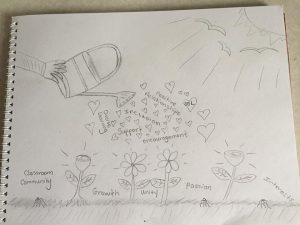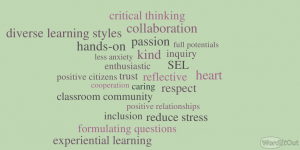
“Teachers are gardeners- Their goal is to cultivate the mind by nourishing, enhancing the climate, removing the weeds and other impediments, and then standing back and allowing growth to occur.” -adapted from Apps, J. 1991
“Educating the mind without educating the heart is no education at all”. –Aristotle
As an educator, I believe that it is my responsibility to not only educate student’s minds but to also educate their hearts. My purpose is to spark passion, interest and curiosity in the hearts of my students while allowing them to realize their own potentials. I believe that incorporating Social and Emotional Learning allows students to feel nurtured and safe in the classroom where their passions and interests can guide their learning. By incorporating the five Social and Emotional Learning competencies, I will create a classroom environment where students feel like it’s okay to make mistakes without fear or failure, feel they can succeed at learning if they try their best and are confident to take risks. I aim to reduce stress and anxiety in my students by providing my students with the skills and tools needed to self-regulate. I believe that by having students knowledgeable on how to regulate their emotions, more learning and student engagement will take place. I bring social and emotional themes into the classroom through incorporating children’s literature, brain breaks, goal setting and class discussion about SEL topics.
I believe that through building a classroom community and positive environment, students will feel safe and eager to learn and positive relationships will be the result. I believe a positive classroom community can be reached through group work where students are given the opportunity to work with one another in a variety of team building and cooperative tasks resulting in trust and respect. A classroom is a place where collaboration between students and their peers is important because it allows for new perspectives and new viewpoints to drive the classroom learning. Students feel like they can share their thoughts within a safe environment without judgment. Conversation between one another in the classroom will help create a classroom that is diverse and a place where every student feels like their uniqueness is appreciated. I welcome open discussion in the classroom and think-pair shares in order to ensure that my students feel valued and appreciated and these relationships are built.
It’s important to me as an educator that every student feels valued and included and that individual learning styles are taken into account. I bring multimodal approaches into the classroom to account for these different learning styles and provide continuous support to all students. As a teacher, it is my responsibility to know who each of my learners are, what kinds of knowledge and experience they bring into the classroom, where their interests and passions lie, and what they want to accomplish so that I can tailor lessons and classroom activities that fit to their needs. I believe that an inclusive classroom is so important because it’s a place where all students voices are being heard and all needs are being met and supported, and it’s a foundation for all learners regardless of ability to learn together. I provide the scaffolding students need in order to build connections between what they already know and their new understandings in order to ensure learning is a gradual process and that teacher support is provided every step of the way.
In order to be a successful educator, I believe it’s important to provide students with the motivation to learn and grow. I want students to be engaged and academically fulfilled during the progression of a typical school day. My goal as an educator is for students to feel interested, excited, and enthusiastic when it comes to learning. I increase student engagement through experiential learning where I bring hands-on learning experiences into the classroom where students are involved in their own learning and real-world connections can be made. I believe in taking ordinary subjects and topics and innovating them to a new level where students are now actively participating in their own learning, are moving around the classroom for an intellectual purpose, and are interacting with their peers towards a common goal; learning now becomes memorable and fun. I embrace active learning activities because they stimulate teamwork and cooperative problem solving and lay the groundwork for life-long collaborative practice. I foster critical thinking skills upon my students by bringing topics and issues into the classroom that allow my students to think about the world around them in a new and critical way. By doing so, I believe that students will learn how to analyze, question, and develop higher order thinking as well as develop the necessary skills needed to become positive citizens and role-models in their community.
